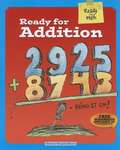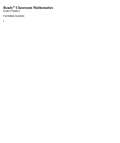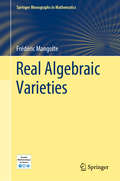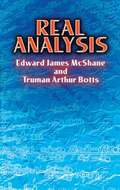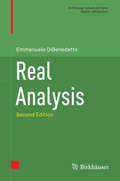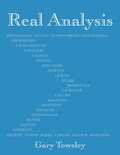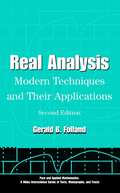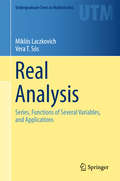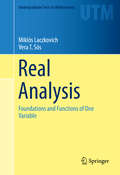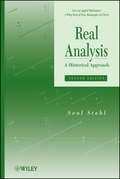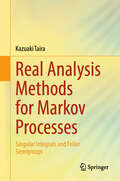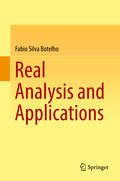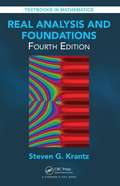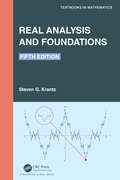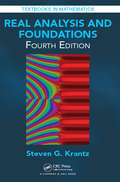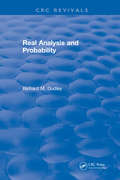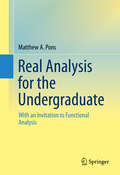- Table View
- List View
Ready Tennessee, Mathematics Instruction [Grade] K
by Danielle Curran Pam Halloran Kathy Kellman Theresa MacVicar Dawn Nuttall Lauren Van Wart O'Lamar GibsonNIMAC-sourced textbook
Ready Tennessee, Mathematics Practice and Problem Solving [Grade 1]
by Kathy Kellman Ruth Estabrook Matt Pollock Penny Dowdy Pamela Halloran Sarah Kraus Djana Paper Susan Rogalski Sam Valentino Julia BourqueNIMAC-sourced textbook
Ready Tennessee, Mathematics Practice and Problem Solving [Grade] 7
by Pam Halloran Lauren Van Wart Sarah Kraus Sam Valentino Stacie CartwrightNIMAC-sourced textbook
Ready Tennessee, Mathematics Practice and Problem Solving [Grade] 8
by Pam Halloran Kathy Kellman Lauren Van Wart Ruth Estabrook Matt Pollock Penny Dowdy Sarah Kraus Sam Valentino Stacie CartwrightNIMAC-sourced textbook
Ready for Addition (Ready for Math)
by Wingard-Nelson RebeccaMath is all around, and an important part of anyone's life. You use math when you're playing games, cooking food, spending money, telling time, reading music, or doing any other activity that uses numbers. This book covers one-digit, two-digit, and three-digit addition. Learn about partial sums, regrouping, and place value. Add money, time, and key words too!
Ready, Mathematics Practice and Problem Solving [Grade] 2
by Ron Larson Laurie BoswellNIMAC-sourced textbook
Real Algebraic Varieties (Springer Monographs in Mathematics)
by Frédéric MangolteThis book gives a systematic presentation of real algebraic varieties. Real algebraic varieties are ubiquitous.They are the first objects encountered when learning of coordinates, then equations, but the systematic study of these objects, however elementary they may be, is formidable. This book is intended for two kinds of audiences: it accompanies the reader, familiar with algebra and geometry at the masters level, in learning the basics of this rich theory, as much as it brings to the most advanced reader many fundamental results often missing from the available literature, the “folklore”. In particular, the introduction of topological methods of the theory to non-specialists is one of the original features of the book. The first three chapters introduce the basis and classical methods of real and complex algebraic geometry. The last three chapters each focus on one more specific aspect of real algebraic varieties. A panorama of classical knowledge is presented, as well as major developments of the last twenty years in the topology and geometry of varieties of dimension two and three, without forgetting curves, the central subject of Hilbert's famous sixteenth problem. Various levels of exercises are given, and the solutions of many of them are provided at the end of each chapter.
Real Analysis
by Truman Arthur Botts Edward James McShaneThis text offers upper-level undergraduates and graduate students a survey of practical elements of real function theory, general topology, and functional analysis. Beginning with a brief discussion of proof and definition by mathematical induction, it freely uses these notions and techniques. The maximality principle is introduced early but used sparingly; an appendix provides a more thorough treatment. The notion of convergence is stated in basic form and presented initially in a general setting. The Lebesgue-Stieltjes integral is introduced in terms of the ideas of Daniell, measure-theoretic considerations playing only a secondary part. The final chapter, on function spaces and harmonic analysis, is deliberately accelerated. Helpful exercises appear throughout the text. 1959 edition.
Real Analysis
by Emmanuele DibenedettoThe second edition of this classic textbook presents a rigorous and self-contained introduction to real analysis with the goal of providing a solid foundation for future coursework and research in applied mathematics. Written in a clear and concise style, it covers all of the necessary subjects as well as those often absent from standard introductory texts. Each chapter features a "Problems and Complements" section that includes additional material that briefly expands on certain topics within the chapter and numerous exercises for practicing the key concepts. The first eight chapters explore all of the basic topics for training in real analysis, beginning with a review of countable sets before moving on to detailed discussions of measure theory, Lebesgue integration, Banach spaces, functional analysis, and weakly differentiable functions. More topical applications are discussed in the remaining chapters, such as maximal functions, functions of bounded mean oscillation, rearrangements, potential theory, and the theory of Sobolev functions. This second edition has been completely revised and updated and contains a variety of new content and expanded coverage of key topics, such as new exercises on the calculus of distributions, a proof of the Riesz convolution, Steiner symmetrization, and embedding theorems for functions in Sobolev spaces. Ideal for either classroom use or self-study, Real Analysis is an excellent textbook both for students discovering real analysis for the first time and for mathematicians and researchers looking for a useful resource for reference or review.
Real Analysis
by Gary TowsleyThis text is a conventional coverage of Real Analysis for undergraduate students. In it, the real numbers are developed via the Completeness Axiom. The topology of the real numbers is also explored. The coverage culminates in proving the two parts of the Fundamental Theorem of Calculus.
Real Analysis
by Gerald B. FollandAn in-depth look at real analysis and its applications-now expanded and revised. This new edition of the widely used analysis book continues to cover real analysis in greater detail and at a more advanced level than most books on the subject. Encompassing several subjects that underlie much of modern analysis, the book focuses on measure and integration theory, point set topology, and the basics of functional analysis. It illustrates the use of the general theories and introduces readers to other branches of analysis such as Fourier analysis, distribution theory, and probability theory. This edition is bolstered in content as well as in scope-extending its usefulness to students outside of pure analysis as well as those interested in dynamical systems. The numerous exercises, extensive bibliography, and review chapter on sets and metric spaces make Real Analysis: Modern Techniques and Their Applications, Second Edition invaluable for students in graduate-level analysis courses. New features include: * Revised material on the n-dimensional Lebesgue integral. * An improved proof of Tychonoff's theorem. * Expanded material on Fourier analysis. * A newly written chapter devoted to distributions and differential equations. * Updated material on Hausdorff dimension and fractal dimension.
Real Analysis
by Miklós Laczkovich Vera T. Sós Gergely BálintThis book develops the theory of multivariable analysis, building on the single variable foundations established in the companion volume, Real Analysis: Foundations and Functions of One Variable. Together, these volumes form the first English edition of the popular Hungarian original, Valós Analízis I & II, based on courses taught by the authors at Eötvös Loránd University, Hungary, for more than 30 years. Numerous exercises are included throughout, offering ample opportunities to master topics by progressing from routine to difficult problems. Hints or solutions to many of the more challenging exercises make this book ideal for independent study, or further reading.Intended as a sequel to a course in single variable analysis, this book builds upon and expands these ideas into higher dimensions. The modular organization makes this text adaptable for either a semester or year-long introductory course. Topics include: differentiation and integration of functions of several variables; infinite numerical series; sequences and series of functions; and applications to other areas of mathematics. Many historical notes are given and there is an emphasis on conceptual understanding and context, be it within mathematics itself or more broadly in applications, such as physics. By developing the student’s intuition throughout, many definitions and results become motivated by insights from their context.
Real Analysis
by Miklós Laczkovich Vera T. SósBased on courses given at Eötvös Loránd University (Hungary) over the past 30 years, this introductory textbook develops the central concepts of the analysis of functions of one variable -- systematically, with many examples and illustrations, and in a manner that builds upon, and sharpens, the student's mathematical intuition. The book provides a solid grounding in the basics of logic and proofs, sets, and real numbers, in preparation for a study of the main topics: limits, continuity, rational functions and transcendental functions, differentiation, and integration. Numerous applications to other areas of mathematics, and to physics, are given, thereby demonstrating the practical scope and power of the theoretical concepts treated. In the spirit of learning-by-doing, Real Analysis includes more than 500 engaging exercises for the student keen on mastering the basics of analysis. The wealth of material, and modular organization, of the book make it adaptable as a textbook for courses of various levels; the hints and solutions provided for the more challenging exercises make it ideal for independent study.
Real Analysis
by N. L. CarothersThis course in real analysis is directed at advanced undergraduates and beginning graduate students in mathematics and related fields. Presupposing only a modest background in real analysis or advanced calculus, the book offers something of value to specialists and nonspecialists alike. The text covers three major topics: metric and normed linear spaces, function spaces, and Lebesgue measure and integration on the line. In an informal, down-to-earth style, the author gives motivation and overview of new ideas, while still supplying full details and complete proofs. He provides a great many exercises and suggestions for further study.
Real Analysis
by Peter A. LoebThis textbook is designed for a year-long course in real analysis taken by beginning graduate and advanced undergraduate students in mathematics and other areas such as statistics, engineering, and economics. Written by one of the leading scholars in the field, it elegantly explores the core concepts in real analysis and introduces new, accessible methods for both students and instructors. The first half of the book develops both Lebesgue measure and, with essentially no additional work for the student, general Borel measures for the real line. Notation indicates when a result holds only for Lebesgue measure. Differentiation and absolute continuity are presented using a local maximal function, resulting in an exposition that is both simpler and more general than the traditional approach. The second half deals with general measures and functional analysis, including Hilbert spaces, Fourier series, and the Riesz representation theorem for positive linear functionals on continuous functions with compact support. To correctly discuss weak limits of measures, one needs the notion of a topological space rather than just a metric space, so general topology is introduced in terms of a base of neighborhoods at a point. The development of results then proceeds in parallel with results for metric spaces, where the base is generated by balls centered at a point. The text concludes with appendices on covering theorems for higher dimensions and a short introduction to nonstandard analysis including important applications to probability theory and mathematical economics.
Real Analysis
by Saul StahlA provocative look at the tools and history of real analysisThis new edition of Real Analysis: A Historical Approach continues to serve as an interesting read for students of analysis. Combining historical coverage with a superb introductory treatment, this book helps readers easily make the transition from concrete to abstract ideas.The book begins with an exciting sampling of classic and famous problems first posed by some of the greatest mathematicians of all time. Archimedes, Fermat, Newton, and Euler are each summoned in turn, illuminating the utility of infinite, power, and trigonometric series in both pure and applied mathematics. Next, Dr. Stahl develops the basic tools of advanced calculus, which introduce the various aspects of the completeness of the real number system as well as sequential continuity and differentiability and lead to the Intermediate and Mean Value Theorems. The Second Edition features:A chapter on the Riemann integral, including the subject of uniform continuityExplicit coverage of the epsilon-delta convergenceA discussion of the modern preference for the viewpoint of sequences over that of seriesThroughout the book, numerous applications and examples reinforce concepts and demonstrate the validity of historical methods and results, while appended excerpts from original historical works shed light on the concerns of influential mathematicians in addition to the difficulties encountered in their work. Each chapter concludes with exercises ranging in level of complexity, and partial solutions are provided at the end of the book.Real Analysis: A Historical Approach, Second Edition is an ideal book for courses on real analysis and mathematical analysis at the undergraduate level. The book is also a valuable resource for secondary mathematics teachers and mathematicians.
Real Analysis Methods for Markov Processes: Singular Integrals and Feller Semigroups
by Kazuaki TairaThis book is devoted to real analysis methods for the problem of constructing Markov processes with boundary conditions in probability theory. Analytically, a Markovian particle in a domain of Euclidean space is governed by an integro-differential operator, called the Waldenfels operator, in the interior of the domain, and it obeys a boundary condition, called the Ventcel (Wentzell) boundary condition, on the boundary of the domain. Most likely, a Markovian particle moves both by continuous paths and by jumps in the state space and obeys the Ventcel boundary condition, which consists of six terms corresponding to diffusion along the boundary, an absorption phenomenon, a reflection phenomenon, a sticking (or viscosity) phenomenon, and a jump phenomenon on the boundary and an inward jump phenomenon from the boundary. More precisely, we study a class of first-order Ventcel boundary value problems for second-order elliptic Waldenfels integro-differential operators. By using the Calderón–Zygmund theory of singular integrals, we prove the existence and uniqueness of theorems in the framework of the Sobolev and Besov spaces, which extend earlier theorems due to Bony–Courrège–Priouret to the vanishing mean oscillation (VMO) case. Our proof is based on various maximum principles for second-order elliptic differential operators with discontinuous coefficients in the framework of Sobolev spaces. My approach is distinguished by the extensive use of the ideas and techniques characteristic of recent developments in the theory of singular integral operators due to Calderón and Zygmund. Moreover, we make use of an Lp variant of an estimate for the Green operator of the Neumann problem introduced in the study of Feller semigroups by me. The present book is amply illustrated; 119 figures and 12 tables are provided in such a fashion that a broad spectrum of readers understand our problem and main results.
Real Analysis and Applications
by Fabio Silva BotelhoThis textbook introduces readers to real analysis in one and n dimensions. It is divided into two parts: Part I explores real analysis in one variable, starting with key concepts such as the construction of the real number system, metric spaces, and real sequences and series. In turn, Part II addresses the multi-variable aspects of real analysis. Further, the book presents detailed, rigorous proofs of the implicit theorem for the vectorial case by applying the Banach fixed-point theorem and the differential forms concept to surfaces in Rn. It also provides a brief introduction to Riemannian geometry. With its rigorous, elegant proofs, this self-contained work is easy to read, making it suitable for undergraduate and beginning graduate students seeking a deeper understanding of real analysis and applications, and for all those looking for a well-founded, detailed approach to real analysis.
Real Analysis and Foundations (4th Edition)
by Steven G. KrantzThe first three editions of this book have become well established, and have attracted a loyal readership. Students find the book to be concise, accessible, and complete. Instructors find the book to be clear, authoritative, and dependable. We continue to listen to our readership and to revise the book to make it more meaningful for new generations of mathematics students. This new edition retains many of the basic features of the earlier versions. We still cover sequences, series, functions, limits of sequences and series of functions, differentiation theory, and integration theory. The theory of functions of several variables is explored. And introductions to Fourier analysis and differential equations is included to make the book timely and relevant. In this new edition we endeavor to make the book accessible to a broader audience. We do not want this to be perceived as a “high level” text. Therefore we include more explanation, more elementary examples, and we stepladder the exercises. We update and clarify the figures. We make the sections more concise, and omit technical details which are not needed for a solid and basic understanding of the key ideas.
Real Analysis and Foundations (Textbooks in Mathematics)
by Steven G. KrantzThrough four editions this popular textbook attracted a loyal readership and widespread use. Students find the book to be concise, accessible, and complete. Instructors find the book to be clear, authoritative, and dependable. The primary goal of this new edition remains the same as in previous editions. It is to make real analysis relevant and accessible to a broad audience of students with diverse backgrounds while also maintaining the integrity of the course. This text aims to be the generational touchstone for the subject and the go-to text for developing young scientists. This new edition continues the effort to make the book accessible to a broader audience. Many students who take a real analysis course do not have the ideal background. The new edition offers chapters on background material like set theory, logic, and methods of proof. The more advanced material in the book is made more apparent. This new edition offers a new chapter on metric spaces and their applications. Metric spaces are important in many parts of the mathematical sciences, including data mining, web searching, and classification of images. The author also revised the material on sequences and series adding examples and exercises that compare convergence tests and give additional tests. The text includes rare topics such as wavelets and applications to differential equations. The level of difficulty moves slowly, becoming more sophisticated in later chapters. Students have commented on the progression as a favorite aspect of the textbook. The author is perhaps the most prolific expositor of upper division mathematics. With over seventy books in print, thousands of students have been taught and learned from his books.
Real Analysis and Foundations (Textbooks in Mathematics)
by Steven G. KrantzThe first three editions of this popular textbook attracted a loyal readership and widespread use. Students find the book to be concise, accessible, and complete. Instructors find the book to be clear, authoritative, and dependable. The goal of this new edition is to make real analysis relevant and accessible to a broad audience of students with diverse backgrounds. Real analysis is a basic tool for all mathematical scientists, ranging from mathematicians to physicists to engineers to researchers in the medical profession. This text aims to be the generational touchstone for the subject and the go-to text for developing young scientists. In this new edition we endeavor to make the book accessible to a broader audience. This edition includes more explanation, more elementary examples, and the author stepladders the exercises. Figures are updated and clarified. We make the sections more concise, and omit overly technical details. We have updated and augmented the multivariable material in order to bring out the geometric nature of the topic. The figures are thus enhanced and fleshed out. Features A renewed enthusiasm for the topic comes through in a revised presentation A new organization removes some advanced topics and retains related ones Exercises are more tiered, offering a more accessible course Key sections are revised for more brevity
Real Analysis and Probability
by R. M. DudleyWritten by one of the best-known probabilists in the world this text offers a clear and modern presentation of modern probability theory and an exposition of the interplay between the properties of metric spaces and those of probability measures. This text is the first at this level to include discussions of the subadditive ergodic theorems, metrics for convergence in laws and the Borel isomorphism theory. The proofs for the theorems are consistently brief and clear and each chapter concludes with a set of historical notes and references. This book should be of interest to students taking degree courses in real analysis and/or probability theory.
Real Analysis for the Undergraduate
by Matthew A. PonsThis undergraduate textbook introduces students to the basics of real analysis, provides an introduction to more advanced topics including measure theory and Lebesgue integration, and offers an invitation to functional analysis. While these advanced topics are not typically encountered until graduate study, the text is designed for the beginner. The author's engaging style makes advanced topics approachable without sacrificing rigor. The text also consistently encourages the reader to pick up a pencil and take an active part in the learning process. Key features include: - examples to reinforce theory; - thorough explanations preceding definitions, theorems and formal proofs; - illustrations to support intuition; - over 450 exercises designed to develop connections between the concrete and abstract. This text takes students on a journey through the basics of real analysis and provides those who wish to delve deeper the opportunity to experience mathematical ideas that are beyond the standard undergraduate curriculum.

